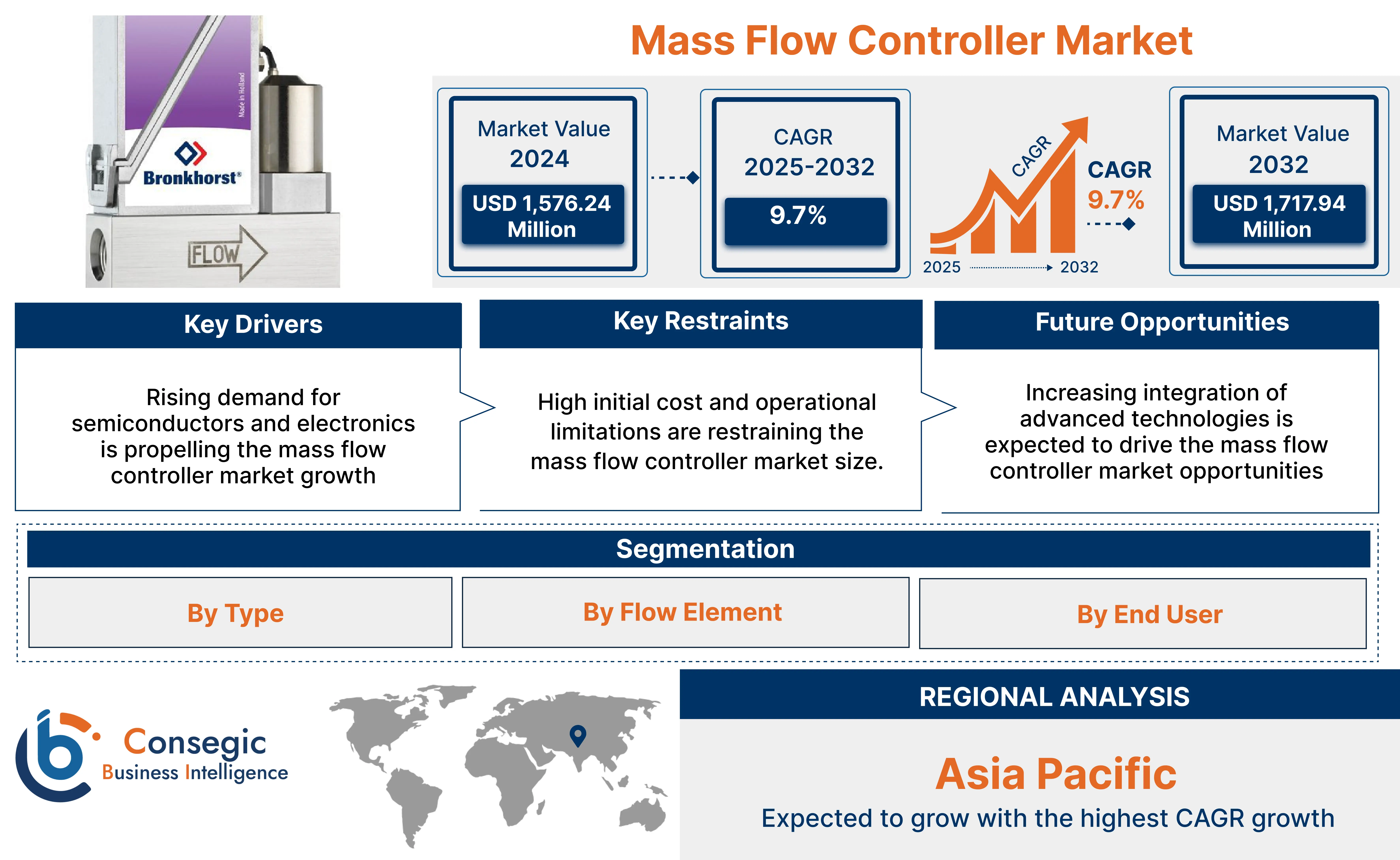Mass Flow Controller Market Size:
Mass Flow Controller Market size is estimated to reach over USD 3,612.26 Million by 2032 from a value of USD 1,576.24 Million in 2024 and is projected to grow by USD 1,717.94 Million in 2025, growing at a CAGR of 9.7% from 2025 to 2032.
Mass Flow Controller Market Scope & Overview:
A mass flow controller (MFC) refers to a flow control device that is designed to measure mass flow irrespective of temperature and pressure. Moreover, they are primarily measured using thermal and coriolis method and are widely used in semiconductor and electronics manufacturing processes. Additionally, flow controllers offer a wide range of features such as less thermal damage to sensors, low risk of thermal decomposition, and high-speed flow control capability, among others. Further, the rising technological advancements related to flow controllers are driving the market.
Mass Flow Controller Market Dynamics - (DRO) :
Key Drivers:
Rising demand for semiconductors and electronics is propelling the mass flow controller market growth
The rising adoption of flow controllers is primarily driven by the increasing adoption of semiconductors and electronics. Moreover, semiconductor manufacturers relies heavily on flow controllers as they provide precise control of gas and liquid flows for various types of processes like deposition, etching, and doping. Additionally, flow controllers in semiconductor manufacturing are used to control the flow of gases as well as for process control and quality assurance in electronics manufacturing.
- For instance, Teledyne Technologies provides thermal flow controllers, which offers high accuracy, precision, and others in semiconductor processing.
Thus, the rising adoption of flow controllers for semiconductor and electronics manufacturing is propelling the mass flow controller market expansion.
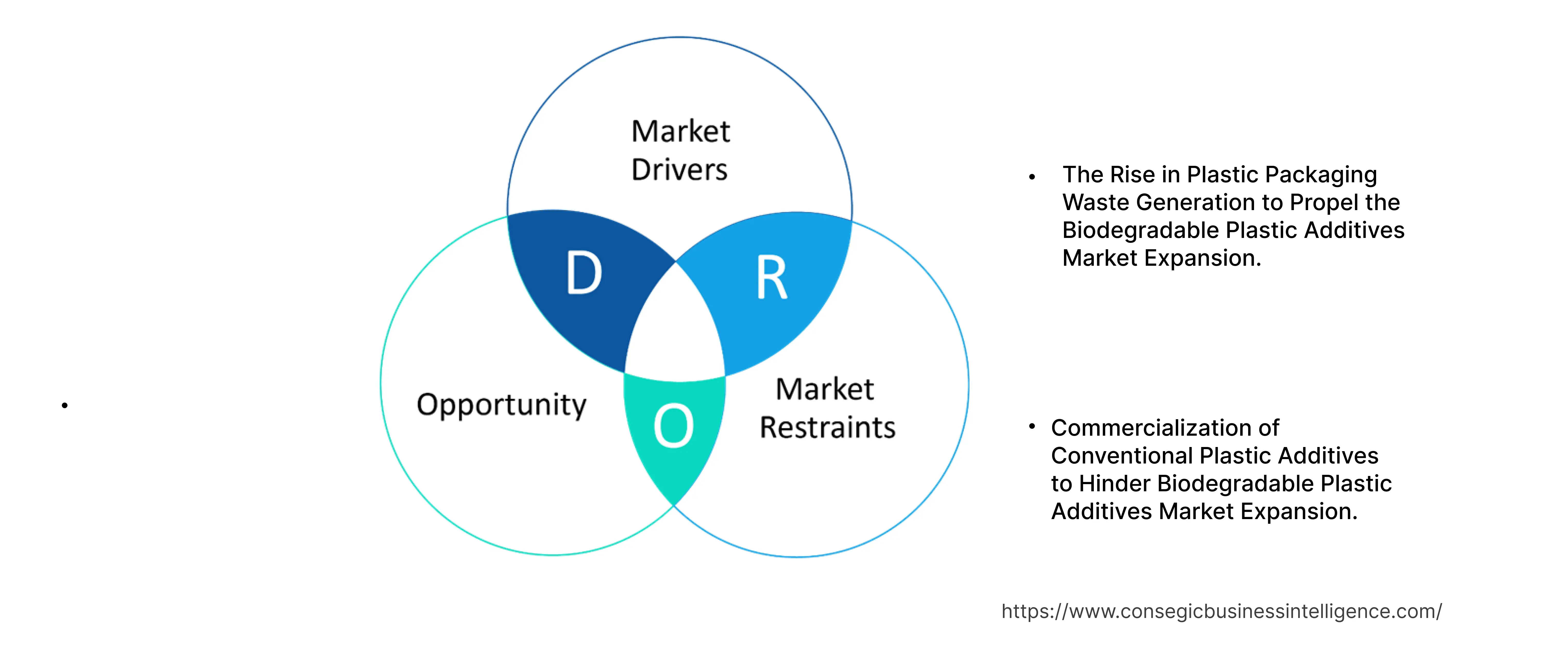
Key Restraints:
High initial cost and operational limitations are restraining the mass flow controller market size.
The flow controller includes integration of sensors, control valves, and feedback electronics, which often leads to higher initial investment and complexities. Moreover, this complexity can impact the market growth.
Additionally, implementation of MFC requires robust control policies to address factors like pressure variations, sensor response times, and the need for precise flow control. Therefore, the aforementioned factors are hindering the mass flow controller market.
Future Opportunities :
Increasing integration of advanced technologies is expected to drive the mass flow controller market opportunities
The increasing integration of advanced technologies related to flow controllers is driving the market. Advanced technologies like micro-electro-mechanical systems, through chip sensors, digital control systems, and others are utilized by a wide range of industries like pharmaceutical, chemical, food and beverages, and others. Moreover, digital control system offers various features such as multi-gas and multi-range capabilities, which is further driving the need for flow controllers.
- For instance, in March 2023, Sensirion AG launched its new SFC6000 model of flow controller that offers a wide range of features like light weight, high accuracy, wide dynamic range, and enhanced speed. The flow controller is suitable for applications involving semiconductor manufacturing, industrial automation, and others.
Therefore, the increasing integration of advanced technologies in flow controllers is projected to boost the mass flow controller market opportunities during the forecast period.
Mass Flow Controller Market Segmental Analysis :
By Type:
Based on type, the market is segmented into differential pressure flow controllers, thermal flow controllers, coriolis flow controllers, and others.
Trends in the type:
- There is an increasing trend towards the adoption of thermal flow controllers due to the rise in integration with industrial automation systems, which is further driving the market.
- Increasing trend in adoption of coriolis flow controllers due to its high precision is driving the mass flow controller market growth.
Thermal flow controllers segment accounted for the largest revenue share in the overall mass flow controller market share in 2024.
- Thermal flow controllers are devices that measure the low mass flow rate of gases and liquids using a heat element and temperature sensors.
- Moreover, thermal flow controllers are used in a wide range of industries such as petrochemicals, food and beverage, semiconductor manufacturing, and others for higher precision.
- For instance, Bronkhorts High Tech B.V. offers a wide range of thermal flow controllers for gases and liquids in its product offerings, which have measurement capabilities between 0-5 g/h.
- Hence, rising advancements related to thermal flow controllers are driving the market growth.
Coriolis flow controller segment is anticipated to register a substantial CAGR growth during the forecast period.
- Coriolis flow controller is a device that utilizes coriolis effect to accurately control and measure the mass flow rate of gas and liquid.
- Moreover, coriolis flow controllers are widely used in various types of industrial applications for accurate measurement, as they offer high precision and ability to measure mass flow directly.
- For instance, in September 2023, Brooks Instrument released the Quantim QMC series of coriolis flow controllers that offers high accuracy along with multivariable outputs, including mass flow, volume flow, and others.
- Hence, increasing advancements associated with coriolis flow controllers are projected to drive the mass flow controller market size during the forecast period.
By Flow Element:
Trends in the flow element:
- Increasing technological advancements associated with digital MFCs for measuring gas and liquid flow are driving the market demand.
- Rising adoption of gas flow controllers due to increasing use in several industrial applications, including semiconductor, chemicals, and others, is driving the market.
The gas segment accounted for the largest revenue in the overall mass flow controller market share in 2024, and it is anticipated to register a significant CAGR growth during the forecast period.
- Gas flow controller regulates the flow of gases by maintaining a specific mass flow rate passing through a given point per unit time.
- They offer various types of features like flow measurement, closed-loop control, set points, and others.
- Moreover, gas flow meter controllers are utilized in a wide range of industries including semiconductor manufacturing, chemical processing, research and development, and others.
- For instance, Horiba offers a wide range of flow controllers, which are specifically designed to measure and control the flow rate of gas.
- Therefore, according to analysis, rising advancements related to MFCs are further projected to drive the market during the forecast period.
By End User:
Based on end user, the market is segmented into semiconductor & electronics, chemicals, pharmaceuticals, oil & gas, food & beverages, energy & power, and others
Trends in the end user:
- Increasing use of flow controllers in semiconductor and electronics due to increasing need for semiconductors in several industries and rising electronics production is driving the mass flow controller market trends.
- Rising trend in adoption of flow controllers in pharmaceutical industry due to lower power consumption and improved operational efficiency is driving the market.
The semiconductor & electronics segment accounted for the largest revenue share of 31.43% in the overall market in 2024.
- In semiconductor sector, mass flow controllers are integrated into gas delivery systems, which are specifically responsible for delivering specific gases to various types of process chambers.
- Moreover, flow controllers are adopted by various electronics manufacturing processes and applications to ensure high precision and accuracy, which is critical in several electronic manufacturing steps.
- For instance, Sierra Instruments offers various other types of flow controllers for semiconductor and electronics industries that can measure and control gas mass flow rates of dry gas, including mixtures, toxins, and others.
- Therefore, according to the mass flow controller market analysis, the above factors are driving the mass flow controller market trends.
The pharmaceuticals segment is anticipated to register the fastest CAGR growth during the forecast period.
- Pharmaceutical manufacturing involves with various types of gases for various applications, including chemical synthesis, solvent vaporization, and others.
- Moreover, MFCs play a vital role in maintaining flow rates of the gases to ensure consistency and precision.
- For instance, Siemens offers precision and universal coriolis flow sensors, which are utilized in flow controllers to ensure accurate and reliable mass flow rate.
- Hence, according to the market analysis, the above factors are projected to boost the market during the forecast period.
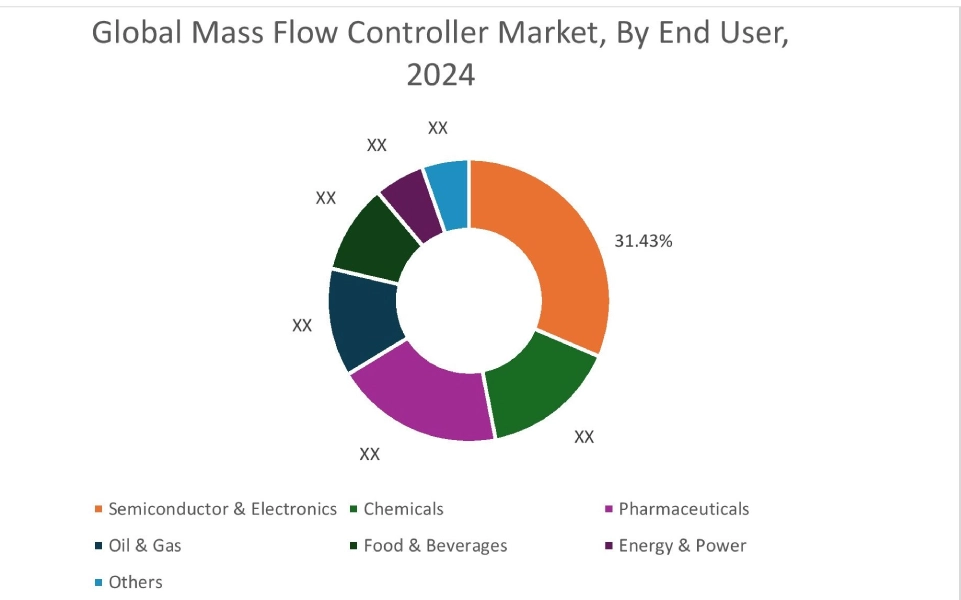
Regional Analysis:
The regions covered are North America, Europe, Asia Pacific, Middle East and Africa, and Latin America.
>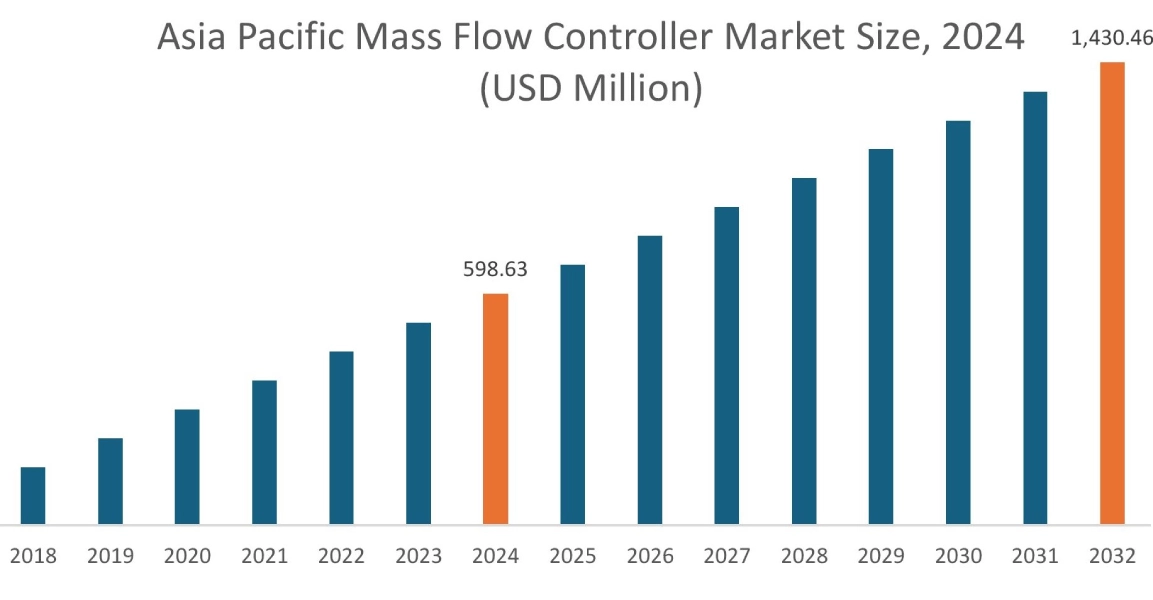
Asia Pacific region was valued at USD 598.63 Million in 2024. Moreover, it is projected to grow by USD 654.77 Million in 2025 and reach over USD 1,430.46 Million by 2032. Out of this, China accounted for the maximum revenue share of 37.15%. As per the mass flow controller market analysis, the adoption of MFCs in the Asia-Pacific region is primarily driven by the rising integration of flow controllers with automation systems for chemicals, pharmaceuticals, and oil & gas sectors, among others. Additionally, the rising advancements related to sensor technology, digital control systems, and others are further accelerating the mass flow controller market expansion.
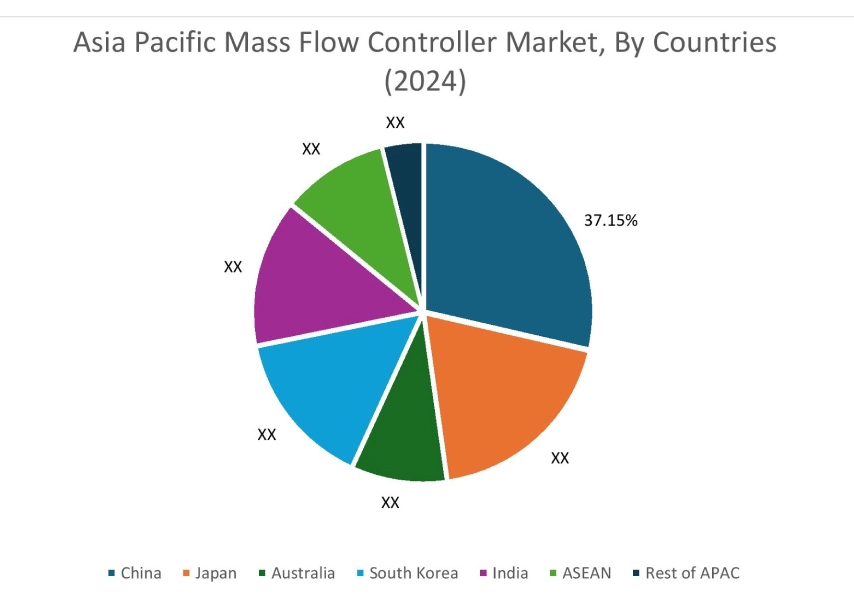
North America is estimated to reach over USD 1,051.17 Million by 2032 from a value of USD 461.86 Million in 2024 and is projected to grow by USD 503.10 Million in 2025. In North America, the adoption of flow controllers is driven by an increasing use in renewable applications, rising semiconductor and electronics production, along with increasing progressions associated with thermal flow controllers in the region. Similarly, rising developments associated with the semiconductor & electronics sector are contributing to the mass flow controller market demand.
Additionally, the regional analysis depicts that the growing adoption of differential pressure flow controllers due to its seamless integration with industrial control systems, along with rising demand for accurate and precise flow measurements in industrial sectors are driving the mass flow controller market demand in Europe. Furthermore, as per the market analysis, the market demand in Latin America, Middle East, and African regions is expected to grow at a considerable rate due to factors such as significant investments in pharmaceuticals, semiconductors, and other industrial sectors, increasing investments to facilitate industrial automation, and others.
- For instance, Azbil, a Japan-based company, offers flow controllers with compact design, which are 50% smaller than conventional models, contributing to miniaturization in equipment.
- For instance, MKS Instruments, a U.S.-based company, offers high-performance flow controllers in its product offerings, which are designed to provide high precision and enhanced reliability in regulating gas flow rates.
Top Key Players and Market Share Insights:
The global mass flow controller market is highly competitive with major players providing solutions to the national and international markets. Key players are adopting several strategies in research and development (R&D), product innovation, and end-user launches to hold a strong position in the mass flow controller industry. Key players in the mass flow controller industry include-
- Horiba Ltd. (Japan)
- Brooks Instrument (U.S.)
- Sensirion AG (Switzerland)
- Tokyo Keiso Co., Ltd. (Japan)
- Azbil Corporation (Japan)
- MKS Instruments (U.S.)
- Bronkhorst High-Tech B.V. (Netherlands)
- Aalborg Instruments & Controls, Inc. (U.S.)
- Sierra Instruments, Inc. (U.S.)
- Teledyne Hastings Instruments (U.S.)
Mass Flow Controller Market Report Insights :
| Report Attributes | Report Details |
| Study Timeline | 2019-2032 |
| Market Size in 2032 | USD 3,612.26 Million |
| CAGR (2025-2032) | 9.7% |
| By Type |
|
| By Flow Element |
|
| By End User |
|
| By Region |
|
| Key Players |
|
| North America | U.S. Canada Mexico |
| Europe | U.K. Germany France Spain Italy Russia Benelux Rest of Europe |
| APAC | China South Korea Japan India Australia ASEAN Rest of Asia-Pacific |
| Middle East and Africa | GCC Turkey South Africa Rest of MEA |
| LATAM | Brazil Argentina Chile Rest of LATAM |
| Report Coverage |
|
Key Questions Answered in the Report
How big is the mass flow controller market? +
The mass flow controller market was valued at USD 1,576.24 Million in 2024 and is projected to grow to USD 3,612.26 Million by 2032.
Which is the fastest-growing region in the mass flow controller market? +
Asia-Pacific is the region experiencing the most rapid growth in the mass flow controller market.
What specific segmentation details are covered in the mass flow controller report? +
The mass flow controller report includes specific segmentation details for type, flow element, end user, and region.
Who are the major players in the mass flow controller market? +
The key participants in the mass flow controller market are Horiba Ltd. (Japan), Brooks Instrument (U.S.), MKS Instruments (U.S.), Bronkhorst High-Tech B.V. (Netherlands), Aalborg Instruments & Controls, Inc. (U.S.), Sierra Instruments, Inc. (U.S.), Teledyne Hastings Instruments (U.S.), Sensirion AG (Switzerland), Tokyo Keiso Co., Ltd. (Japan), Azbil Corporation (Japan) and others.
